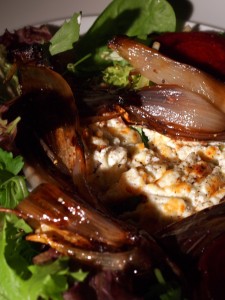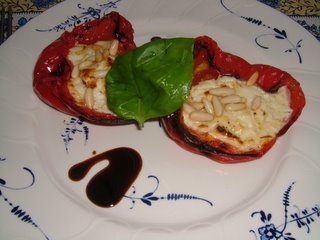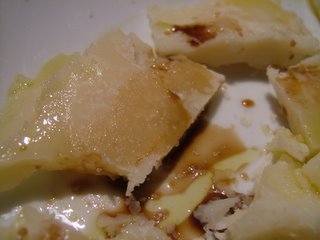 You are smarter than I am, and therefore you’ll glance at this picture and think, “Silly woman. She should have bought a cheese with a rind.” You’d be absolutely right, and if you’re making this and want your cheese to hold a nice shape when grilled you’ll need something with a rind. My excuse: my cheese was in a little cardboard box and I made assumptions about the presence of a rind that wasn’t there.
You are smarter than I am, and therefore you’ll glance at this picture and think, “Silly woman. She should have bought a cheese with a rind.” You’d be absolutely right, and if you’re making this and want your cheese to hold a nice shape when grilled you’ll need something with a rind. My excuse: my cheese was in a little cardboard box and I made assumptions about the presence of a rind that wasn’t there.
I get through a lot of shallots, but I do make an effort to buy the longer kind (sometimes sold as “banana” shallots, sometimes as “echalion”), which grow here in East Anglia from September to May. They’re larger than the round variety you’ll be buying for the rest of the year, and easier to handle – the flavour is very similar. If you’re using round shallots here, be aware that they might need five minutes or so less cooking time.
Don’t use the wallet-assaultingly expensive, 20-year-old balsamic in a teensy-weensy vial that you bought on your romantic trip to Modena. That one’s for drizzling on Parmesan and perhaps dribbling on some very good bread with a little olive oil that’s been standing on some smashed garlic for an hour or so. For this recipe, you just need the supermarket stuff that comes in large bottles.
I’ve suggested two nut oils to use to dress the salad. I love a light nut oil to finish this sort of dish – buy a small bottle and keep it in the fridge, though, because nut oils go rancid quickly if kept in a cupboard. Experiment! You can buy all kinds of interesting nut oils, like macadamia, pistachio and pine nut, in delicatessens, and this salad is a good place to try them out.
To serve four as a light lunch or starter (all depending on how much crusty bread you intend to go through), you’ll need:
450g banana shallots, peeled and quartered
½ teaspoon salt
25g soft dark brown sugar
75ml balsamic vinegar
2 tablespoons extra-virgin olive oil
200g goats’ cheeses, in a log with a rind
2 tablespoons hazelnut or walnut oil
Salad leaves to serve
Preheat the oven to 220°C (430°F).
When you have peeled and quartered the shallots, use a fork to whisk the olive oil, balsamic vinegar, salt and sugar together in a large bowl. Drop the shallots in and turn them carefully to coat them in the mixture. The shallots shouldn’t fall apart completely, but don’t worry if a few of them shed chunks.
Pour the whole contents of the bowl into a metal baking tray, spreading everything out so the dressed shallots are in one even layer. Roast for 15 minutes, turn, roast for another 15 minutes until dark brown and caramelised, and set aside to cool.
When you are ready to serve the salad, cut the cheese into four discs and grill them on one side until gold and bubbling. Lay out a large handful of salad leaves on each plate, put a cheese in the centre and scatter a quarter of the shallot pieces around the cheese. Grate a generous amount of pepper over the whole salad and drizzle with your choice of nut oil before serving.


